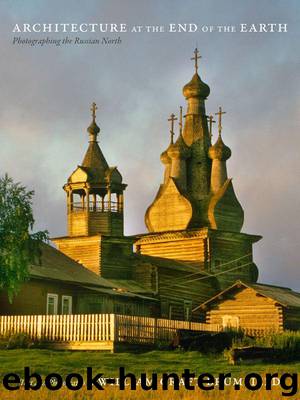Architecture at the End of the Earth: Photographing the Russian North by Brumfield William Craft

Author:Brumfield, William Craft [Brumfield, William Craft]
Language: eng
Format: azw3, epub
ISBN: 9780822375432
Publisher: Duke University Press
Published: 2015-06-07T16:00:00+00:00
BELOZERSK AND THE SOUTHERN SHORE OF WHITE LAKE
The river system descending from the Vytegra eventually leads to the White Lake, or “Beloe Ozero,” the territory of one of Russia’s most ancient settlements. The origins and early location of Belozersk, a town of some ten thousand in the Vologda region, are dim and uncertain. Nonetheless, “Beloozero” is considered among the oldest recorded settlements among the eastern Slavs, mentioned in the Primary Chronical under the year 862 as one of the five towns granted to the Varangian (or Viking) brothers Riurik, Sineus, and Truvor, invited (according to the chronicle) to rule over the eastern Slavs in what was then called Rus.
Whatever the details of its history, it is clear from the name that the town was always closely connected with White Lake (Beloe Ozero), a large body of fresh water in northwestern Russia. Although smaller than Lakes Ladoga and Onega, White Lake is a pivotal link between those two lakes and the Russian heartland. On the southeast end White Lake drains into the Sheksna, a tributary of the Volga and the route of many summer cruise boats between Moscow and St. Petersburg.
The early Beloozero—as it was originally called—was at a different location on White Lake, and the town was again resettled until it occupied its current place in the late fourteenth century. As Moscow’s power increased in the fifteenth century, Beloozero gained strategic importance as a bulwark on Muscovy’s northwestern frontier and its water transportation routes. Ivan III (the Great) understood the significance of this location, and in 1487 he constructed a large fortress, or kremlin, whose earthen ramparts still stand.
The town prospered during the middle of the sixteenth century, particularly as a source of iron goods and fish. An impressive visible reminder of that wealth is the fortresslike Church of the Dormition, begun in 1553 on one of the town’s highest points. Beloozero witnessed the disruptions of the latter part of the reign of Ivan the Terrible (r. 1547–84), when the town was included in his personal domain (oprichnina) and served as a place of exile.
The inclusion of Beloozero in Ivan’s domains did not prevent it from experiencing the famine and disease inflicted on much of the rest of Russia in the late sixteenth century. And during the Time of Troubles (the dynastic crisis following the death of Tsar Boris Godunov in 1605), the year 1612 brought a full measure of devastation with the sack of Beloozero by a marauding force. With the revival of trade in the seventeenth century, Beloozero’s location and natural resources again proved advantageous. During the reign of Aleksei Mikhailovich, the Cathedral of the Transfiguration was built within the kremlin in the 1670s.
With the founding of St. Petersburg in 1703, Beloozero found itself in a pivotal position between the Volga River Basin and the large northwestern lakes Onega and Ladoga, which led via the Neva River to the new imperial capital. In 1777 the town’s name was formally changed to Belozersk, and the next year it gained
Download
Architecture at the End of the Earth: Photographing the Russian North by Brumfield William Craft.epub
This site does not store any files on its server. We only index and link to content provided by other sites. Please contact the content providers to delete copyright contents if any and email us, we'll remove relevant links or contents immediately.
Shoot Sexy by Ryan Armbrust(17663)
Portrait Mastery in Black & White: Learn the Signature Style of a Legendary Photographer by Tim Kelly(16957)
Adobe Camera Raw For Digital Photographers Only by Rob Sheppard(16908)
Photographically Speaking: A Deeper Look at Creating Stronger Images (Eva Spring's Library) by David duChemin(16623)
Bombshells: Glamour Girls of a Lifetime by Sullivan Steve(13981)
Art Nude Photography Explained: How to Photograph and Understand Great Art Nude Images by Simon Walden(12977)
Perfect Rhythm by Jae(5327)
Pillow Thoughts by Courtney Peppernell(4215)
The Book of Joy by Dalai Lama(3904)
Good by S. Walden(3490)
The Pixar Touch by David A. Price(3369)
A Dictionary of Sociology by Unknown(3032)
Fantastic Beasts: The Crimes of Grindelwald by J. K. Rowling(2997)
Humans of New York by Brandon Stanton(2835)
Stacked Decks by The Rotenberg Collection(2812)
Read This If You Want to Take Great Photographs by Carroll Henry(2664)
On Photography by Susan Sontag(2578)
Insomniac City by Bill Hayes(2501)
Photographic Guide to the Birds of Indonesia by Strange Morten;(2492)
